IDP News Issue No. 16
- Celebrating the Centenary
- 2000 International Conference on Dunhuang Studies by Roderick Whitfield
- International Academic Conference on the Centenary of the Discovery of the Dunhuang Library Cave by Frances Wood
- 'Respect, Understanding and Good Faith'
- Publications
- Conferences
- Current Research
- News
- Project News
Celebrating the Centenary
A Special Issue Devoted to the Events in the 100th Year After the Dunhuang Library Cave Discovery
This issue of IDP News is devoted to the conferences, exhibitions and publications which took place during the centennial year of the discovery of the Dunhuang Library Cave (pictured below right in 1907, showing the small door to Cave 17 leading off the corridor in cave 16) by the monk, Wang Yuanlu (pictured below left outside the small temple facing Cave 16 which he made his home). All these events were immensely successful and a fitting celebration to the wonderful discovery. They show the depth and breadth of Dunhuang studies across the world and the organisers and participants are to be congratulated on making 2000 such a memorable and exciting year.

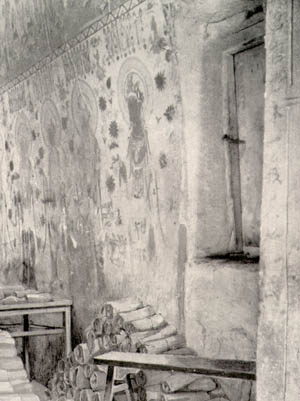
There is a article on the conference at the Dunhuang Academy, held in August. Capital Normal University in Beijing also hosted a major conference and a full report is given below. Exhibitions were held at the Dunhuang Academy, the National Library of China and the History Museum. 2000 has also been a bumper year for Dunhuang publications and some of these are listed below.
The Chinese quotation was used by Professor Zhang Gong as the title of an article published in Guangming Ribao on 22 June, 2000, to coincide with the centenary. In the article the author reproduces his diary of his first visit to London in August 1987 to discuss the beginning of an international collaboration, as Chinese scholars from the Institute of History, Chinese Academy of Social Sciences worked together with British colleagues on the photography, research and compilation of the 14 facsimile volumes of Dunhuang Manuscripts in British Collections published by Sichuan People's Publishing House. An extract is given below.
2000 International Conference on Dunhuang Studies
Dunhuang Academy, 29 July - 3 August 2000
The Dunhuang Academy hosted its annual conference on Dunhuang Studies in August. Many of the participants travelled directly from a symposium organised by the Institute for the Promotion of Chinese Culture in Hong Kong.
The Academy has spent the last few years working tremendously hard to restore Wang Yuanlu's old house, directly opposite the Library Cave, and to organise an exhibition there. Both were a great success.
A report of the conference is given below by Professor Roderick Whitfield. Papers will be published next year.
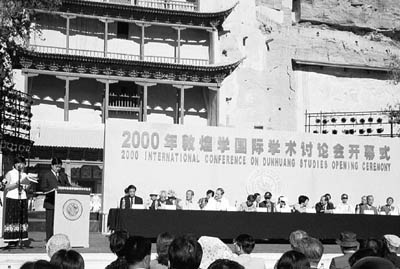
Right:The opening ceremony outside the nine-storey pagoda at the Dunhuang caves
Celebrating the centenary of the discovery of the Dunhuang Library Cave and the founding of Dunhuang Studies, this conference was impressive in every way. The proceedings opened promptly on 29 July in the brilliant morning sunshine outside the nine-storey pagoda sheltering the Northern Colossus, near the mid-point of the cliff. This has long been a landmark of the cliff face, but now the history of the great seated Maitreya has been newly made clear by the revelation of the five floor levels of the cave, from the time of Empress Wu in the late seventh century to the Mongols in the fourteenth. Also opened and lit for visitors are the sockets for the great wooden scaffold erected for the purpose of past refurbishments of the 33-metre image, as well as a sample section of the five skims of clay plaster corresponding to those occasions. Several hundred guests and the media contingent sat or hovered to the east in the cooling shade of the trees facing the cliff, while the honoured guests sat opposite, as if newly reborn in the Pure Land of the West, dazzled if not yet fully enlightened. Fortunately, after the welcoming speeches, and an impressive group photograph, the proceedings were adjourned for the seven opening keynote addresses in plenary session in the large lecture theatre of the Academy, packed to capacity and over.
The keynote speakers well represented the international character of Dunhuang studies, beginning with Professor Jao Tsung-i (Rao Zongyi) from Hong Kong, a doyen of the study of both Dunhuang manuscripts and of visual materials, especially the ink drawings to which he was the first to consecrate a monograph. It was under his auspices, and those of the Hong Kong Institute for the Promotion of Chinese Culture, that another well-attended conference devoted to Dunhuang had been held at the University of Hong Kong the previous week.
Passing over the writer's brief contribution on the wider context of the art of Dunhuang, the other keynote speakers included Professor Lev Menshikov, from the Institute of Oriental Studies, St. Petersburg who sketched the early history of Russian contributions to Dunhuang studies from the 1930s until the beginning of his own involvement in 1957; Professor Ikeda On from Japan; Professor Jiang Boqin of Guangzhou who spoke with truly passionate oratory and enthusiasm about the site and for all those who had been involved with it; Professor Lee Soo-woong from Korea; and finally, to introduce the Mellon Foundation's ambitious project to provide a digital record of the caves, William G. Bowen from the United States.
Under the guidance of Professor Fan Jinshi, Director of the Dunhuang Academy, the complex arrangements for the week-long conference were carried out to perfection. Days of the presentation of papers were alternated with visits. With the Academy's published excavation and numbering of the caves at the northern end of the Mogao cliff, there are now more than 730 caves in all at the main site. In addition, both the Western Thousand Buddha Caves and the Yulin Caves were open for visiting, the latter with a spacious new access route from the cliff top to the river bed, leading to the caves on both sides of the river. Extensive coverage by the media, with many entire pages in broadsheet papers, showed the determination of those involved to show how Dunhuang studies worldwide are now led by Chinese scholars and more particularly by members of the Academy. At the same time, there was a truly warm welcome for international participants, a common determination to encourage younger scholars, and intense interest, especially on the part of the latter, in new ventures involving digital retrieval of both documentary and visual materials.
Parallel sessions were held to enable the large number of participants to deliver their papers, some 150 in all. The largest section, in which this writer participated, was that for Art and Archaeology (including music and dance), meeting in the main lecture theatre with an audience of some two hundred or more, with professional simultaneous translation provided for Chinese, English and Japanese, and adequate time allowed for discussion. The participants for the sessions on History and Manuscripts, Religion and Culture, and Language and Literature met in adjacent rooms. Abstracts of some 190 papers (including some not actually presented at the conference), were printed in both Chinese and English in a volume of 476 pages, in itself no mean feat of organization; it is intended to publish all the papers in 2001.
A number of papers concerned the future Buddha, Maitreya. Among them, Zhang Yuanlin's paper on the relationship between the main statue and the narrative paintings in Cave 275, one of the three earliest caves, was particularly interesting as he made a persuasive case for reconsidering the encounter scenes on the south wall, hitherto thought to represent the life of Sakyamuni, as relating instead to Maitreya. Zhang noted that whereas in earlier translations it is said that Maitreya became a Buddha because of his perfection of skilfulness, from 401 onwards Kumarajiva's translations of the Maitreya sutras include mention of his parents, and of his charitable feelings towards human suffering, inter alia, not previously mentioned. Thus the iconography of the whole cave would concern Maitreya. There was further discussion of Cave 275 by Yin Guangming, also of the Dunhuang Academy, who considered its date in relation to the dated stone stupas of the Northern Liang period and the adjacent caves, proposing a date between 433 and 439 for Cave 268, and not earlier than 436 for Cave 275. Images of Maitreya from this and other caves, as well as gilt bronze images and images from the Sui and Tang dynasties, were discussed in several other papers.
Ning Qiang, formerly at the Academy and now teaching in the University of Michigan, studied the additional niche dedicated to Bhaishajyaguru in Cave 220, where two characters including the Tibetan Emperor as a beneficiary had been erased from the inscription at some time after the end of the Tibetan occupation. He further noted the subtleties of the representation of deceased parents and living relatives in the Tibetan period: living donors whose surnames revealed them to be Han Chinese were nevertheless shown wearing Tibetan costume, but their deceased parents could still be shown in Chinese dress. As a result, somewhat fewer donors came to be portrayed.
There were some impressive papers by Japanese scholars. Professor Donohashi Akio considered issues concerning the construction of Sui dynasty caves, particularly when these had originally been cut under the Northern Dynasties. Ms Yamasaki Toshiko, speaking in faultless Chinese, examined Cave 217, created during the transition from the first half to the second half of the early Tang. Using overlays, she demonstrated how elements of the Paradise architecture and the corresponding elements in Cave 71 derived from a common prototype, and then analyzing some of the ornamental elements used in the period of Empress Wu and Zhongzong, to conclude that Cave 217 dates, like Cave 323, from the end of the early Tang period.
Jeor Hae-ju, one of the ten Korean delegates to the conference, analyzed the representations of the nine assemblies in seven locations of the Avatamsaka sutra, considering examples in Koryo and Choson as well as the 29 caves with this subject-matter in Dunhuang (previously only six were generally recognized), and revealing the different schemes of arrangement among them, as well as the inclusion or not of the scenes of the pilgrimage of Sudhana.
Papers in the art and archaeology session extended to Kizil and to the Yulin caves, as well as to portable shrines such as the ivory niche from Yulin and the materials from Kharakhoto in the collection of the State Hermitage, St Petersburg, introduced by Kira Samosyuk. The discussions, in spite of limitations of time, were often quite spirited. A century after the discovery of the hidden library on June 22, 1900, the Dunhuang Academy, under Professor Fan Jinshi, is clearly moving fast. Apart from the Academy's own substantial quarterly of Dunhuang Studies, there are extensive publications presenting previously unpublished materials, such as the twenty-odd volumes published by the Jiangsu Fine Arts Press, with comprehensive coverage of individual caves, and, now appearing, twenty-eight thematically arranged volumes published by the Commercial Press, Hong Kong. These developments, and the spirit of openness so evident in the conference, cannot fail to attract an increasing number of scholars to become involved in the field of Dunhuang studies, that has so much to offer.
Roderick Whitfield is Professor in the Art and Archaeology Department, SOAS, London University, and Corresponding Fellow of the Dunhuang Academy.
International Academic Conference on the Centenary of the Discovery of the Dunhuang Library Cave
Capital Normal University, Beijing, 21-25 June, 2000
Capital Normal University was the venue for the June centennial conference, organised by with great success by Professor Hao Chunwen and his colleagues. A report is given below by Dr Frances Wood.
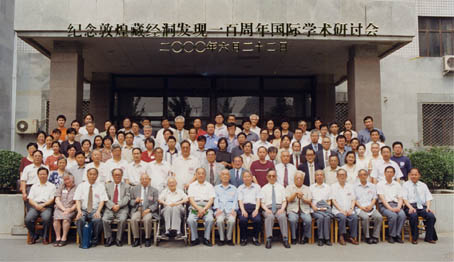
Left:Participants outside Capital Normal University
Later in the summer Dunhuang exhibitions were held at the National Library of China and the History Museum. Details of the exhibition catalogues are given below.
The conference was held in the Capital Normal University and very well organised by Professor Hao Chunwen and his research students from the Department of History. It was attended by scholars and research students from history faculties all over China and there were delegates from Japan, Taiwan, Singapore, the ex-Soviet Union, France and the UK.
At the opening ceremony, senior members of the Dunhuang-Turfan Academic Society presided, and their contribution to Dunhuang studies was commemorated in several volumes published to coincide with the conference. Yingguo shoucang Dunhuang Han Zang wenxian yanjiu (Research into Chinese and Tibetan documents from Dunhuang in British Collections), published by the Academy of Social Sciences, edited by Song Jiayu and Liu Zhong, covered the history of the Stein collection in London, their storage, numbering and conservation, as well as cataloguing efforts and international scholarship based on the collections. It is based upon the pioneering collaborative facsimile edition Ying cang Dunhuang wenxian in which members of the Dunhuang-Turfan Academic Society played such an important role, both in organisation and participation.
It was fortunate that on 22 June, the Guangming Daily chose to publish a whole page of reminiscence of that collaborative effort, written by Zhang Gong who spent many months in London with Song Jiayu, working on the Stein collection and preparing the way for the eventual publication. For those of us who were involved from the beginning but had not kept diaries, Zhang Gong's account raised many happy memories.
Another major publication that appeared on the first day of the conference was the first volume of Dr Fang Guangchang's catalogue of the Buddhist fragments in the Stein collection (Or.8210/S.7000 and above for details see below). Dr Fang's dedication to his task is phenomenal and his achievement is extraordinary, particularly since he has been working on the collections in the National Library at the same time.
A facsimile project which follows on from Ying cang Dunhuang wenxian is Professor Sha Zhi's edition of the paper manuscripts found by Stein on his Third Expedition, which will be published at the end of the year by the Shanghai Cishu chubanshe. Like its predecessor, the intention is to make the materials easily available to scholars and students in China.
There were full sessions of papers every day and all were of a consistently high standard. Many revealed close and painstaking work on individual manuscripts and some were more wide-ranging. It was useful to be among Dunhuangologists but in a Chinese context for once, since the rapt attention paid to Professor Hao Chunwen, for example, when he demonstrated his database of transcriptions (on which he had been working in London for almost a year) underlined the importance given to the task by his Chinese colleagues.
It was also interesting to hear Professor Rong Xinjiang on the amount of work that remained to be done in pursuit of genuine Dunhuang materials in Chinese collections. This involved work on the papers of nineteenth and early twentieth century local officials in the Dunhuang area and collectors, whose late classical style was something of a puzzle to Tang specialists.
There was an enormously promising group of young research students from Chinese universities whose epigraphic and historical skills and open minds promise well for the future. I was happy to discover how many of them were familiar with the IDP web-site and full of praise for its aims and potential. This seemed particularly important in the light of an air of resitutionism in China's newspapers throughout the summer.
The atmosphere of the conference was a very positive one. I was very happy to see so many old friends again, particularly those with whom we have worked for considerable periods in recent years, and I was very impressed with the fine publications that have recently appeared. My only regret was that a couple of Western scholars who had announced their intention of attending, and had, in the light of their achievements been awarded places on the high table at the opening conference, did not attend. They missed a warm and stimulating meeting.
Dr Frances Wood is Head of the Chinese Section at the British Library.
'Respect, Understanding and Good Faith'
The following extract is from an article by published in the daily paper Guangming Ribao on 22 June, 2000, 'Reminiscence of Dunhuang Manuscripts in British Collections'. The author, Zhang Gong of the Institute of History, Chinese Academy of Social Sciences,was a member of the editorial team for this publication and during his first visit to London in 1987 he kept a diary. After two weeks of examining the manuscripts, he and Song Jiayu realised the importance of producing facsimiles of all the non-canonical Buddhist material. This extract is taken from after they have broached this possibility with the British Library.
Being able to talk so freely, on such friendly terms, and the trustfulness of the British Library were all completely contrary to our expectations. There was no limit to photogaphy; the Library had already thought about producing an illustrated volume, and this indicated that they were prepared to co-operate with us. Song Jiayu and I dared to think that we should no longer restrict ourselves to a selection, but should struggle to publish facsimiles of all of the thousands of manuscripts, only excluding the Buddhist sutras. If we were to do this, then the quantity would be considerable and money would be the greatest obstacle. But if we could resolve the financial problem, then co-operation could be successful. We immediately telephoned to China to the Head of the Institute to inform him of our new plan. Dr Sarah Allen later joked that the British Library had not understood us at all at the beginning; they had suspected we were like many people who came to England saying they were going to do research, but really came to have fun and never went near the Library. From the [university] hall where we were staying to the Library was ten minutes on foot and, while in England, Song Jiayu and I moved only between two points: the hall and the Library, except on Sundays. Our hosts understood: 'Song and Zhang are here to do research.' Respect, understanding and good faith were sprouting.
(translated by Frances Wood)
Publications
Books
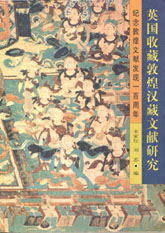
Yingguo Shoucang Dunhuang Han Zang Wenxian Yanjiu
Song Jiayu, Liu Zhong (eds.)
The Chinese Academy of Social Science, Beijing, 2000
425pp. RMB 72.00.
Yingguo Tushuguan Cang Dunhuang Yishu Mulu: Stein 6981-8400
Fang Guangchang
Religious Culture Publishing House, Beijing, 2000
491pp., RMB150.00
This is the first of several volumes of Professor Fang Guangchang's catalogue of the Buddhist fragments in the Stein collection. The fragmentary material was omitted by Lionel Giles from his 1953 catalogue and serious work only started on it after conservation was carried out at the British Library with the help of conservators from China. Professors Fang Guangchang and Rong Xinjiang were then invited to prepare catalogues of this previously unknown material. Professor Rong's catalogue of the smaller quantity of non-Buddhist material appearing in 1995 along with the facsimile volumes making this material available to a much larger audience. The Buddhist fragments will gradually be entered onto the IDP database.
Dunhuang Mogaoku Beiqu Shiku (Northern Grottoes of Mogaoku, Dunhuang), vol.1.
Peng Jinzhang and Wang Jianjun of The Dunhuang Academy
Cultural Relics Publishing House, Beijing 2000
405pp., 32 colour pls., 128 pls., RMB 350.00
Between 1988 and 1995, the Dunhuang Academy led by Professor Peng Jinzhang, made a series excavation in every cave of the Northern section, where Pelliot had found many Uighur Buddhist texts of the Yuan Dynasty in Caves 464 and 465 (Pelliot Nos. 181 and 182). They discovered documents in Chinese, Xixia, Tibetan, Uighur, Bhags-pa, Sanskrit, and even Syrian, as well as other materials, dating from the Tang to the Yuan. All of the material will be published in the three volumes of the archaeological report, entitled Dunhuang Mogaoku Beiqu Shiku. The first volume, published in July 2000, inlcudes documents found in caves 1-94. The most interesting text is a Psalm from the Syrian Bible, which has been deciphered by Dr. Duan Qing of Peking University.
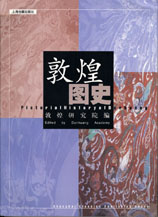
Dunhuang Tushu: Pictorial History of Dunhuang
The Dunhuang Academy (eds.)
Shanghai Classics Publishing House, Shanghai, 2000
144pp. b&w pl. only,
RMB 75.00.
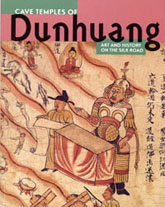
Cave Temples of Dunhuang/Mogao: Art and History of the Silk Road
Roderick Whitfield, Susan Whitfield and Neville Agnew
The British Library and Getty Publications, London and Los Angeles, 2000
144 colour and 2 b/w ills., 1 map, GB£20.00 and US$29.95.

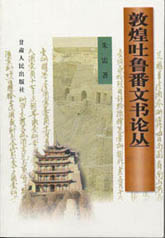
Dunhuang Turfan Wenshu Luncong
Zhu Lei
Gansu Renmin chubanshe, Lanzhou, 2000
RMB 25.00.
Gansu Cang Dunhuang Wenxia
Gansu Renmin chubanshe, Lanzhou, 2000
A catalogue of a selection of the finest Dunhuang manuscripts in Gansu collections, with full colour plates and an introduction by the former Director of the Dunhuang Academy, Duan Wenjie.
Sand Buried Ruins of Khotan
M. A. Stein, Books for Travel, 2000, GB£135.
This is an exact facsimile of the original 1903 first edition this popular book, including Stein's own photographs and maps and bound in its famous red cover.
Details from:
tel: +44 (0) 1985 850583
fax: +44 (0) 1985 850478
http://www.booksfortravel.org.uk.
Exhibition Catalogues
Dunhuang Yishu Jingpinxuan: Zhongguo Guojia Tushuguan Cang
Ren Jinian, 62pp., 97 colour pls.
Catalogue of the centennial exhibition held at the National Library of China, Beijing.
Dunhuang: Jinian Dunhuang Cangjingdong Faxian Yi Bai Zhounian
Zhang Wenbin (Editor-in-Chief), Chaohua Publishing House, Beijing,
2000,186pp., full colour plates throughout, RMB98.
Catalogue of the centennial exhibition held at the History Museum, Beijing.
Journals
Dunhuang Tulufan yanjiu(Journal of Dunhuang and Turfan Studies)
Vol.4 (1999)
A special issue on Turfan, it includes most of the papers presented to the Third Conference on the Silk Road held at Yale University in June 1998. The publication of this issue, along with that of Asia Major,3rd ser.,11.2(1998) and Orientations 30.4(April 1999), marked the completion of the 'Reuniting Turfan's Scattered Treasures' Project joined by the Yale and Peking Universities.
Tun-huang and Turfan Studies (Acta Asiatica: Bulletin of the Institute of Eastern Culture) 78 (2000)
Published by the Toho Gakkai, Tokyo, this special issue contains articles by Donohashi Akio on the Sui caves at Dunhuang; Moriyasu Takao on the Shazhou Uighurs; Takata Tokio on multilingualism in Dunhuang; Yoshida Yutaka on Turfan Iranian manuscripts; and Ikeda On on recent Japanese research on Dunhuang and Turfan.
Conferences
DUNHUANG ART AND SOCIETY
July 15 - 28, 2001
Mogao Caves, Dunhuang, China
The Silkroad Foundation and the Center for Chinese Studies at the University of Michigan will co-sponsor and conduct the second seminar on 'Dunhuang Art and Society' next year at Dunhuang, China, with the support from the Dunhuang Research Academy.
This seminar provides a unique opportunity for scholars and students to research and study the Dunhuang caves on site. Invited speakers include well-known Dunhuang specialists from the United States, the United Kingdom and China. In addition to the introductory lectures, in-depth case studies will be discussed.
Note: Participants of the seminar are also invited to attend an international conference on Dunhuang art and culture at Lanzhou, co-organized by Lanzhou University and University of Michigan, on their way to Dunhuang from July 13 to 14, 2001. This conference is not part of the seminar program. There are also two optional field trips.
Format: Participants visit the Mogao caves in the daytimes and attend the lectures and discussions in the evenings.Language: The official language of the seminar is English. Lectures by local Chinese scholars will be translated.
Invited Speakers: Invited speakers include Dr. Albert Dien, Dr. Ning Qiang and Dr. Robert Sharf from the U.S., Dr. Roderick Whitfield from the U.K., and Ms. Fan Jinshi and Dr. Li Zuixiong, from the Dunhuang Research Academy, China.
Accommodation: The Guest House at the Dunhuang Research Academy - $15 per day (double occupancy). Additional $10 for 3 meals per person per day.
Seminar Fee: The seminar fee is US$500, which covers the tickets to visit the open and special caves, expenses of the seminar room and equipment, use of the local library.
Registration: Registration should be submitted to the Silkroad Foundation by December 31, 2000 (http://www.silk-road.com).
Payment is due by 31 January, 2001 once you are accepted to the program. A maximum of thirty participants will be accepted.
For more information: Prof. Ning Qiang (Ningq@umich.edu)
or email Info@silk-road.com
Silkroad Foundation
P.O. Box 2275
Saratoga, CA 95070, USA
Current Research
Pigments at Dunhuang
Victoria Finlay
I am an arts writer based in Hong Kong, researching the stories behind paints and dyes and pigments. I wish to discover which pigments were used at Dunhuang and any other of the ancient Silk Road mural sites, but have received conflicting theories so far. I am particularly interested in the malachite and greens, but would love to hear about anything to do with the subject. I know from Peter Hopkirk's book, Foreign Devils along the Silk Road, that one of Langdon Warner's missions in his 1925 expedition was to find out more about the pigments, but I do not know whether he or anyone else at Harvard published their findings.
My email is vic@asiaonline.net and I would be grateful for any help (which would, of course, be acknowledged).
News
Stein Day
The annual Stein day was held at the Department of Coins and Medals, the British Museum, on 20 September 2000, organised by Helen Wang. Representatives from most of the UK institutions holding Stein material met informally to discuss their work over the past year and a report was also given on the ongoing project with the Hunagarian Academy of Sciences. John Falconer from the British Library reported that the Academy held original prints of Stein's first expedition.
Early Textiles from the Stein Collection at the V&A
A selection of precious textiles fragments brought back from Central Asia by Stein are now on display in Gallery 98, one of the Textile Study Galleries on the first floor of the Victoria and Albert Museum, London. The textiles were recovered from various sites along the Silk Road. They range in date from the first century BCE to the twelfth century CE. Strong woollens and felts of a workaday nature as well as patterned-dyed and painted silks are on show. The Victoria and Albert Museum's beautiful textiles are early examples of complex weaving techniques and they have retained their jewel-like colours across the centuries.
Information on V&A opening times: +1 44 (0)20 7942 2211
http://www.vam.ac.uk
Reference: Verity Wilson, 'Early Textiles from Central Asia: Approaches to Study, with Reference to the Stein Loan Collection in the Victoria and Albert Museum, London,' Textile History 26, 1 (1995), pp. 23-52.
Project News
The Young and the Old
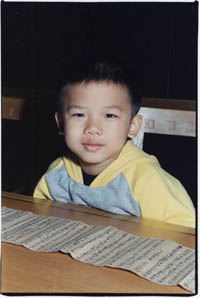
Liao Xingwen (pictured left), a five-year old prodigy at weiqi, visited the British Library in August 2000 during his visit to London for the 4th Mind Sports Olympiad. During his visit he was shown an early treatise on the game, Qijing, one of the manuscripts from Dunhuang (Or.8210/S.5574)
People
Frances Wood and Susan Whitfield gave two lectures on IDP in Hong Kong in June 2000, the first at the Hong Kong Institute for the Promotion of Chinese Culture on Friday 16 and, on the following evening, at the Hong Kong Club to a joint meeting of the Friends of the Oriental Ceramic Society and various art museums. They travelled on to Beijing where they held useful meetings to discuss collaboration with the National Library of China and Peking University Library. Frances remained in Beijing to give further presentations at the Centennial Conference (see above).
Colin Chinnery of IDP gave a well-received presentation on the new IDP map interface at the Dunhuang Centennial Conference (see above). Sam van Schaik, also of IDP, accompanied him and carried out research on Tibetan Dunhuang manuscripts. He was funded by a British Academy Research Grant and a report of his findings will appear in the next issue.
It has been an extremely busy few months with scores of visitors to the British Library Dunhuang Collections. Professor Hao Chunwen completed his one year stay and returned to Capital Normal University in September, after a brief return home in June to organise the Beijing Centennial Conference. Professor Wang Jiqing spent one month in London in May/June working on his account of Stein's 4th expedition.
Over the summer we hosted four scholars from the history departments at the Chinese Academy of Social Sciences and the Academy of Research Into Chinese Medicine to study medical and divination manuscripts, funded by the Welcome Foundation � namely
Professor Xiu Guihua, Dr Zhao Pingan, Dr Liu Lexian and Wang Shumin.
Their visit culminated with a stimulating and well-attended two day conference on Dunhuang Medical Manuscripts, co-hosted by the Needham Research Institute, Cambridge and the School of Oriental and African Studies, London, at which they all presented their finds. The papers will be published and details will be given in a future issue.
We continued to receive visitors from Paris under the Research Project, �Divination, Science and Society in Medieval China, including Catherine Despeux, Guo Zhenzhong and Marc Kalinowski. These scholars also presented papers at the medical conference.
Japanese scholars consulting Dunhuang manuscripts during this period included Fujita Takao, Horie Kyoko, Tsuji Masahiro, Sudo Hirotoshi and Matsui Dai, while Insoo Cho came from Korea.
HEFCE

Sir Brian Fender, Head of the Higher Educational Funding Council for England, and Dr Lynne Brindley, Chief Executive of the British Library (pictured left with Frances Wood and Susan Whitfield), signed a Memorandum of Understanding in July 2000 concerned with IDP and digitisation.
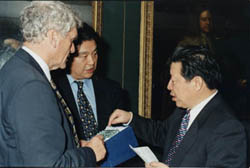
Minister of Culture
The Chinese Minister of Culture, Sun Jiazheng (pictured right), visited the British Library in October and was shown the International Dunhuang Project by Colin Chinnery. The Minister is pictured above making a presentation to the Chairman of the British Library Board, Dr John Ashworth.
ECAI IDP was chosen as the first Examplar Project of the Electronic Cultural Atlas Initiative (ECAI) at the last ECAI conference in January 2000. The British Library was host to the June 2000 conference and Colin Chinnery and Susan Whitfield gave a presentation of the new IDP map interface.
Next Issue The next issue will concentrate on Dunhuang Tibetan Studies. If you have notices of any conferences, publications or other items for inclusion please send them to the editor at the address below by January 5, 2001.
